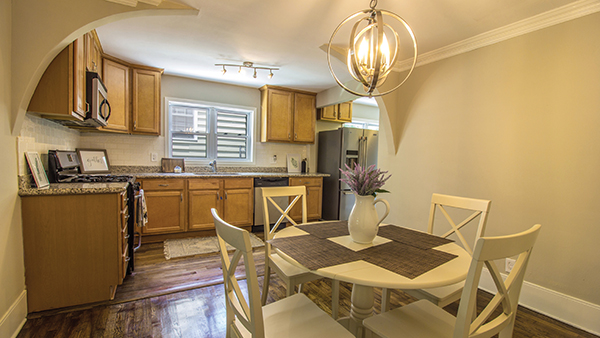These days, so many investors are using the exact same materials over and over again in their flips. For my husband, Ken, and I, we find that when we go outside the box and do things in our investment properties that nobody else is doing in terms of creativity, we are consistently rewarded for that with top dollar at closing. My background is actually in math, so I’m extremely logical and practical, but I’m also very creative as an investor.
In my experience, incorporating design into your investment property can be tricky because you are not designing for a homeowner with a $30,000 budget who can tell you their likes and dislikes as you work. Instead, you are designing for an imaginary buyer – often one with big, beautiful, designer dreams – on a budget that may be microscopic in comparison to the look you want to achieve. To make things even more challenging, your “client” cannot even give you a heads-up as to what they prefer in terms of colors, fixtures, or overall look.
So how to design for an investment property without finding yourself in a “cookie-cutter” situation? Here are my three favorite ways to find out where in any property I will have a chance to let my “creative license” shine through in a way that will also optimize my returns:
#1: I spend some time at the library.
Okay, you caught me. I don’t go to the library. I just do a little online research! My goal is to find out anything I can about the neighborhood in terms of how old it is, if it has any unique aspects that make the homeowners really proud, and, of course, how the homeowners’ association (HOA) governs exterior design, if they do. Most neighborhoods will have some sort of community website dealing with these types of topics, and you will be able to determine a lot just from seeing where the community places the greatest emphasis. You may also be able to glean much of this information from your due diligence and from your experience with other investments.

#2: I take a little walk.
The biggest, most important thing you can do is get to know the neighborhood. That is why you “cyberstalked” your own investment property in step one! You do not necessarily get to know your buyer in advance, but you can design the house in a way that fits the neighborhood but is also unique. This compromise enables you to stand out from the crowd. My favorite example of this is when I see a lot of front porches while I take this walk. If the people in a neighborhood love their front porches, then you make your front porch the best front porch in the neighborhood. Sometimes, that means staging it really well, and other times, you might need to actually do a little work to upgrade the porch area. It will depend on your budget and the neighborhood.
#3: I seek the unusual.
Words like “unusual” and “unique” are not usually words you hear investors use a lot. After all, a lot of us rely on our ability to replicate our investing successes, and that means sticking to a tried-and-true pattern. However, part of my pattern is to find a few unusual and unique things I can emphasize in a home. For example, an old banister is not necessarily something to pull out of the wall and replace with something new and standard. Create a subtle, unique characteristic for the home by restoring it instead. You can also create an unusual, streamlined look by leaving things off. We recently flipped a house that really looked amazing without shutters on the front. We just did not need them. So, we left them off, saved about $500, and had a beautiful home that was just a little bit different than the properties around it as well.

It’s All About Balance
Design is hard under any circumstance because successful design relies on intuition. Fortunately, investors get to bring logic into the equation as well. Don’t be afraid to experiment, but also keep another expert on hand to balance you out. I strike a good balance with my husband and business partner, Ken, because he likes design only just far enough “outside the box” to get that top dollar we talked about earlier. If I get carried away, he can be the voice of reason to bring me back. Conversely, I’m the one who gets to bring a little inspiration and yes, a little color, to our investment properties.
























0 Comments